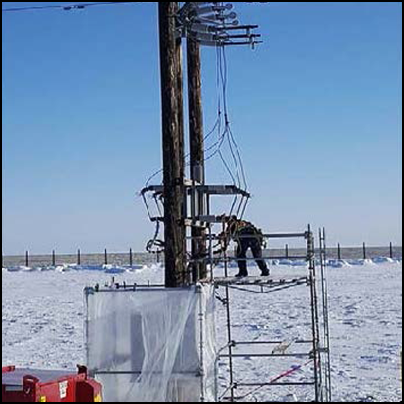-
What happened?
To assist in making a new electrical connection, a scaffold crew was asked to erect scaffolding near uninsulated, energised, power pole components and overhead power lines.
The scaffold crew was unaware that the system was energised.
While the crew erected the scaffold, a contractor supervisor recognised energised electrical equipment and stopped the work.

-
Why did it happen?
The work scope identified the need for energy isolation prior to scaffold work, however, failures in the permit to work and hot work permitting processes meant the work scope was inadequate and relevant work tasks and associated hazards were not considered.
It was not recognised that a unit work permit needed to be obtained for the scaffold task.
Contractor toolbox meeting occurred at the drill site and energy isolation was discussed, however, the scaffold crew did not attend.
Lack of effective pre‐job communication and walk down allowed the scaffold crew to proceed without effective energy isolation in place.

-
What did they learn?
Know and understand:
- How the permit to work (PtW) procedure applies to your scope of work and when permits are required.
- Standard procedure for energy isolation and how it applies to your job tasks.
Review and improve PtW process. If necessary, include practices that focus on electrical work and control of work (field execution, governance, verification).
Always incorporate a pre-job meeting and walkdown with all involved employees to identify critical and high hazard activities.
In safety meetings, reaffirm the need to reassess changing conditions and reaffirm people’s authority to stop work.
When multiple permits are required, consider using a simultaneous operations coordinator/project operator.
If necessary, conduct contractor training/refresher training on energy isolation, PtW roles and responsibilities, hazard recognition and scaffold electrical clearance distances.

-
Ask yourself or your crew
How can something like this happen here?
How do we make sure the right people (or everyone) attends toolbox meetings?
What could have happened if the supervisor did not recognise that the system is energised and initiate stop work procedure?
Have you ever been in a similar position as part of a contracted crew? Why was that?
Do you fully understand when a PtW is required? How can we improve the way we use the PtW system?

Add to homescreen
Content name
Select existing category:
Content name
New collection
Edit collection
What happened?
To assist in making a new electrical connection, a scaffold crew was asked to erect scaffolding near uninsulated, energised, power pole components and overhead power lines.
The scaffold crew was unaware that the system was energised.
While the crew erected the scaffold, a contractor supervisor recognised energised electrical equipment and stopped the work.

Why did it happen?
The work scope identified the need for energy isolation prior to scaffold work, however, failures in the permit to work and hot work permitting processes meant the work scope was inadequate and relevant work tasks and associated hazards were not considered.
It was not recognised that a unit work permit needed to be obtained for the scaffold task.
Contractor toolbox meeting occurred at the drill site and energy isolation was discussed, however, the scaffold crew did not attend.
Lack of effective pre‐job communication and walk down allowed the scaffold crew to proceed without effective energy isolation in place.

What did they learn?
Know and understand:
- How the permit to work (PtW) procedure applies to your scope of work and when permits are required.
- Standard procedure for energy isolation and how it applies to your job tasks.
Review and improve PtW process. If necessary, include practices that focus on electrical work and control of work (field execution, governance, verification).
Always incorporate a pre-job meeting and walkdown with all involved employees to identify critical and high hazard activities.
In safety meetings, reaffirm the need to reassess changing conditions and reaffirm people’s authority to stop work.
When multiple permits are required, consider using a simultaneous operations coordinator/project operator.
If necessary, conduct contractor training/refresher training on energy isolation, PtW roles and responsibilities, hazard recognition and scaffold electrical clearance distances.
Ask yourself or your crew
How can something like this happen here?
How do we make sure the right people (or everyone) attends toolbox meetings?
What could have happened if the supervisor did not recognise that the system is energised and initiate stop work procedure?
Have you ever been in a similar position as part of a contracted crew? Why was that?
Do you fully understand when a PtW is required? How can we improve the way we use the PtW system?
A scaffold crew was directed to erect scaffolding within 15 feet/5 metres of an energised and uninsulated system. Work started, unaware that the system was powered. A supervisor recognised the energised electrical equipment and stopped work immediately.













